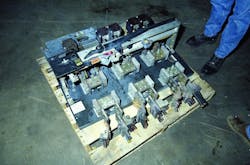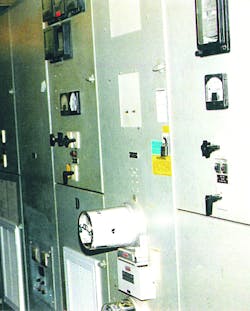EC&M’s Forensic Casebook is one of the magazine’s most popular and enduring departments, as well as the winner of numerous business-to-business journalism accolades in the trade publishing industry over the last 10 years (including a finalist for multiple Jesse H. Neal Awards, American Society of Business Press Editors Awards, and the Western Publication Association’s Maggie Award). This department enables design engineers, electrical technicians/electricians, and plant facility personnel to learn real-world lessons from others’ mistakes in the field by taking an in-depth look at specific electrical accidents from a forensic engineering perspective. Demonstrating the consequences of carelessness, taking shortcuts, or the failure to follow proper safety procedures, Forensic Casebook has featured accident analysis for almost every situation imaginable — dairy farm electrocutions, stray voltage shocks, mismatched capacitor failures, overhead power line contact incidents, houseboat electrocutions, arc flash blasts, transformer failures, and gen-set fires. But most importantly, this department reinforces on a monthly basis just how critical safety is in the electrical industry. Because our issue theme this month is “Health and Safety,” we decided to present some of our readers’ favorite and most memorable Forensic Casebook lessons over the years.
Don't Discount the Danger of 120V
May 2006 issue
By Michael Morse, Ph.D., University of San Diego
An expectation of low risk leads to a life-altering and career-ending injury for one unsuspecting electrician.
More than one electrician has told me — with almost some form of professional pride — that they have been shocked many times by 120V yet no harm has befallen them. A few old timers even talk of how they commonly test “low-voltage” circuits to see if they are live by touching the leads with the back of their hand. After all, as they are quick to point out, 120V isn’t dangerous — unless you get locked on. If you share this cavalier attitude, this case should make you think differently.
For one 45-year-old electrician, the day began like most work days. As an experienced electrician, he was tasked with making an electrical connection between an outdoor pedestal box and a 120V irrigation system controller.
The pedestal was the demarcation boundary between the legal domain of the electric utility and the property owner. The rear of the pedestal (electric utility side) was wired to a transformer. Two 120V phases and a neutral were connected from the transformer to the pedestal box. Mounted on a cement pad, the pedestal was fairly typical. There was ongoing construction, so the pad and road were on a dry, man-made earthen embankment spanning at least 5 ft above the surrounding unexcavated ground.
Two “car-stop” pipes, called bollards, filled with concrete and painted white and measuring 5 in. in diameter, were imbedded in the earth in front of the box to provide protection for the pedestal from traffic on the road. A ground wire was connected to the pedestal box and also connected to a ground rod that was driven into the earth a short distance from the cement pad. The back of the pedestal was locked with the appropriate electric utility tags.
No meter had yet been installed in the pedestal. As such, the gap between the electric utility’s domain and that of the property owner was not bridged — and the front of the box was not energized.
Upon beginning his work, the electrician touched one hand to the top of the pedestal box and the other to one of the bollards. He immediately noticed a mild electrical buzzing sensation and then broke contact. Asking his assistant to bring him an electrical tester to determine what might be energized, he proceeded to test between the pedestal and the bollard, giving him a clear indication that something was energized. Believing that the pedestal, which was obviously connected to a ground post, was not the source, he assumed the bollard was the culprit, chose not to touch it further, and went about his work.
While crouching down, he reached with his right hand to unlatch the front door on the pedestal while steadying himself with the other hand by grabbing the second bollard, which he quite reasonably assumed would not be energized. Suddenly, he found himself locked into an electrical circuit. Unable to free himself from the latch on the pedestal or let go of the bollard, the electrician fought to break free, using his legs to launch himself back into the middle of the road after 3 sec to 10 sec of electrical exposure.
Although the electrician was able to get up and move about immediately following the incident, his assistant called for an ambulance and notified the electric utility. Soon after, however, the victim began to experience muscle fatigue and shooting pains going down his arms and neck. This progressed to tightness in his shoulders and chest pain. Over time, the symptoms grew to include fatigue, dizziness, tingling, generalized weakness, and a “pin-and-needles” feeling. In the end, he was diagnosed with bilateral carpal tunnel syndrome as well as cervical degenerative disease. He also developed personality changes and experienced mood swings and anxiety.
I was contacted by the plaintiff’s attorney and retained as an expert to reconstruct the incident and explain how such a significant electrical injury could occur from a mere 120V contact that lasted only a few seconds.
In the lawsuit that followed, two major issues were challenged by the defense. First, it argued that the shock could not have occurred as the plaintiff testified, asserting that the plaintiff could not have gotten his hand locked behind the latch on the pedestal. Second, it maintained that the victim’s symptoms were extreme — if not ridiculous — for a mere 120V contact.
I made the group aware that a shock of 120V, especially when sweat is present, could have driven a current approaching or possibly even exceeding 500 mA into the plaintiff’s body. After reviewing a video frame by frame (see Photos) in which the plaintiff demonstrated how he grabbed the latch, it was obvious that he could have easily gotten a finger or two into such a position that the current flow, which vastly exceeded the human let-go current (14 mA for adult males), would have locked him in place until he was able to break free. Under the circumstances, a 3-sec to 10-sec shock was completely reasonable. More importantly, I offered testimony about a little-known primary response to electrical contact in which individuals can suffer a broad array of debilitating symptoms from even a brief contact with 120V.
Although I could not state which of the plaintiff’s symptoms were primary or secondary, it was obvious from the chronology — coupled with the electrician’s lack of prior medical history — that the plaintiff’s injuries had a clear and absolute causal connection to the electrical injury that he suffered. Although the jury did find partial fault on the part of the plaintiff, it still returned a verdict of $3.3 million on his behalf.
To read the full story, along with a table showing commonly reported long-term symptoms of diffuse electrical injury, visit http://ecmweb.com/content/dont-discount-danger-120v.
The Case of the Floating Dock
July 2010 issue
By John Cavallaro, P.E., > Forensic Engineering, Inc.
A boy is electrocuted after a severed ground wire and water buildup in a junction box make for a fatal electrical combination at a lake house’s dock.
What started out as a beautiful day at a lake house quickly turned to tragedy for a grandfather/grandson duo, who decided to go swimming off the dock and were soon joined by some neighbor children. Because he did not own a boat, the grandfather raised the metal rails of the lift (Photo ) about 2 ft out of the water, operating a 1-hp motor connected to a pulley system with metal cables.
Noticing a child swinging from the metal rails of the boat lift, the grandfather immediately told the child to get off. After they began to have fun, another child, standing in the water and not touching anything, said he felt a tingle in his legs. Perplexed, the grandfather cautiously touched the metal rails. Feeling an electrical shock go up his arm, he immediately said, “Get out of the water, now!”
Standing near the lift controls, he looked down and saw a child floating face down in the water. The grandfather immediately brought the child to the deck’s surface and administered CPR while his wife dialed 911. When the emergency medical staff arrived, they couldn’t revive the child, pronouncing him dead at the scene (cause of death was electrocution).
After the tragic accident, the family of the deceased boy, as well as the grandfather (homeowner), wanted answers. My firm was called in to investigate this accident on behalf of the grandfather, who was being sued by the victim’s family (who also sued the electrician).
My initial investigation uncovered several clues. The dock was fed by an underground feeder (UF) 12-2 rated cable with ground, which was routed from a junction box located in the house’s crawl space. A portion of the UF cable ran along the edge of a deck, exposed to the environment and foot traffic (see relative location of the severed wire under the house to the dock in the Figure ). Fed from a 20A circuit breaker at the main panel, a bare ground wire in the junction box was awkwardly twisted onto a shorter ground wire. I later learned from the electrical inspector that he had found this wire hanging out of the junction box, and it was severed at that point. Upon seeing this, he’d reconnected it to prevent any other ground issues.
The inspector stated the dock was originally built without electricity, and whoever did the wiring never obtained an electrical permit. He also informed me that he had opened a sealed standard plastic junction box under the wood dock and above the water line. He identified that the internal wires served the boat lift motor and were spliced to the house wires with wire nuts. When he removed the cover screws, water poured out of the box. He identified that the ground (green) wire and the phase (black) wire of the 120V UF cable were on the bottom of the box. I noticed a line on the inside of the junction box, suspecting that this was identifying the water level inside the box, with the two wires clearly being below the line.
The house panel’s circuit breaker for this circuit did not have a ground-fault circuit interrupter (GFCI) as per the 1995-1998 NEC, Art. 555, Marina and Boatyards. I noted that the boat lift motor had two GFCI devices connected in series in between the boat lift and the plastic junction box.
If there were two GFCI devices in series, how did the electricity get from the black (hot) wire to the metal rails of the boat lift? The motor casing was metal and was directly attached to a metal plate, which was attached to metal cables supporting the metal rails. Thus, an internal short in the motor’s casing would energize everything back to the metal railings. Or maybe the two wires in the junction box below the water line were the source of the short. Either way, the severed ground wire under the house would not have allowed anything to flow back to the panel’s ground bus. Hence, there would not be a GFCI-sensed voltage imbalance at the lift motor to trip the unit. Both GFCI circuits were on the up side of where the short to ground was located. Effectively, this said the GFCI became unusable as soon as the ground wire became severed.
I had to prove the motor had an internal short to its casing, which would place 120V on the metal cabling and metal boat rails, or that the plastic junction box was filled with enough water to allow a conductive path between the black (hot) wire and the “floating” green (ground) wire. To examine the motor for an internal short, I disconnected the ground wire going from the house to the motor and then energized the motor via the power switch. I made a voltage measurement between the motor’s ground wire and the ground wire going back to the house. I measured 0V, which told me there was no voltage on the motor’s casing. Thus, the only other path would have to be through the water-filled plastic junction box, back to the motor’s ground casing, and down the metal rails. No ground connection back at the house meant the metal rails remained energized until a grounding connection could be made somewhere.
Because the boat dock was made of wood, anyone standing on it would be isolated and wouldn’t receive a shock by touching the metal cables during normal boat lifting operation. When the grandfather lifted the rails out of the water, he disconnected the leakage path, allowing the electricity to remain on the rails. Unfortunately, when the boy hung from the rails with his feet in the water, he provided a direct path for current to flow. However, how the water got into the gasketed, sealed junction box remained a mystery. The wiring feeding the junction box was encased in two plastic conduits, but they were not sealed from the outside humid environment, possibly accumulating condensation over time. The section routed toward the house stopped about halfway along its length. The other section was routed vertically partially up to the GFCI connector. Thus, both ends were open to the elements. I also noticed the plastic junction box was located directly under a seam in the deck boards. If the cover was not sealed completely, then its location would be ideal for water to drip into the box.
This case settled out of court for an undisclosed amount. We can learn several lessons from this accident. First, the electrician should have obtained an electrical permit. The inspection would have uncovered the missing GFCI at the house, and the connection under the house would have been installed to NEC regulations, preventing the severed wire. Eventually, water buildup in the plastic junction box would have tripped the GFCI. Then, the subsequent troubleshooting would have uncovered the problem and led to a fix. The quirky piece of this puzzle is that individually the severed ground wire and water buildup would not have caused this fatality. Together, however, a dangerous electrical condition was lurking under the surface.
To read the full story and view additional graphics, visit http://ecmweb.com/design/case-floating-dock.
The Case of the Blinding Arc Blast
November 2008 issue
By Andrew Paris, P.E., Andersen Engineering
Electrician installing new circuit at packaging plant is temporarily blinded after screwdriver slip triggers arc blast.
When a manufacturer of plastic bag and packaging materials set out to expand its operation, it leased additional space in a large industrial building. While the facility was shut down for one day, an electrical contractor was hired to connect new equipment to the production line and perform final installation details on the electrical system. Upon accepting the job, the electrical contractor most likely did not anticipate any problems with the routine installation, let alone a serious accident that would end in an arc blast, an injured worker, and excessive damage to the facility’s electrical equipment.
The local power utility supplied 480/277V 3-phase electrical service to the facility through a 1,500kVA, pad-mount transformer located on the north side of the building. The service entrance conductors fed into a 3,000A, 480/277V, 3-phase disconnect. In this case, the disconnect was a manually operated, spring-loaded bolted contact switch with quick-positive switching action. A nameplate date code showed it was manufactured in 1969.
The switch was located in the main switchgear area along the interior north wall. Feeder conductors traveled from the switch output buses to various disconnects and subpanels located in the main switchgear area. The production equipment motors and conveyor drives used in the factory were then fed from these subpanels.
To perform their work safely, the electrical contractor de-energized the entire facility by switching off the 3,000A bolted contact switch. After working through the night, the contractor was ready to re-energize the facility, start up the production machinery, and begin any necessary troubleshooting early the next morning. After re-checking the electrical connections, the crew attempted to engage the switch. Unfortunately, the workers discovered that it would not move completely to the ON position.
In this case, there was apparently a mechanical problem within the switch. While it would close electrically, the switch plates would not move to the fully ON position. The electricians tried to fully engage the switch numerous times with no luck. They knew that if the movable and stationary contact plates did not make full contact, the large operating current could result in damaging resistive heating at the contacts.
Troubleshooting the situation, one electrician decided to use a long flat-headed screwdriver as leverage to try to force the switch fully closed. After wedging the tip of the screwdriver between the dead-front panel and the switch arm, he pulled down on the screwdriver handle, using it as a lever to achieve the force necessary to close the switch. As he pressed down on the handle, the tip of the screwdriver slipped through a gap between the switch and the dead-front panel, making contact with a bolt on one of the upper left phase buses inside the panel while the shaft was touching the grounded portion of the switch arm assembly.
This act initiated a direct phase-to-ground short, resulting in an intense arc blast. Fortunately for the electrician, the main force of the blast shunted downward and was partially blocked by the dead-front panel. Because he was holding onto the insulated screwdriver handle, he was not shocked. However, he was shaken and temporarily blinded for a few hours by the flash of light generated in the arcing event.
The building owner hired a different electrical contractor to replace the damaged switchgear and feeder conductors. This new contractor replaced the feeder conductors and connections. Its employees also allegedly cleaned the switch and put it back into service. Along with the replaced transformer, the electrical system operated properly for the next few days. However, the switch began tripping about a week later, so workers at the plant braced the switch arm closed with a piece of 2 × 4 lumber.
The ensuing inspection showed the switch arm was actually broken. Although it’s unknown how this occurred, we believe this possibly happened when the switch attempted to trip while being held closed — or it may have been stressed from multiple actuation attempts.
The arcing event caused further problems as well. Although the switch appeared to sustain little physical damage, it should not have been put back into service. If the bolted switch plate connections are not tight (and do not have low resistance throughout), hot spots can develop at the higher resistance areas. High-resistance heating can melt the switch plates, permanently damaging the switch, and possibly even weld the contact plates together, preventing the switch from opening if a downstream fault occurs.
Not much is known about the safety measures taken by the original electrical contractor during the installation of the new equipment. However, the contractor should have been following the rules laid out in the NEC, as well as NFPA 70E: Standard for Electrical Safety in the Workplace. The employees were actuating a switch with the panelboard cover closed, and were not working on exposed, energized conductors. Based on that fact, some may conclude that NFPA 70E arc-flash PPE requirements don’t apply, However, even a dead-front panel will not block severe arc blasts. In a situation such as this, when working on equipment in an unknown condition, it’s best to be as safe as possible.
Looking at the 2004 edition of NFPA 70E, in lieu of flash hazard analysis, Table 130.7(C)(9)(a) should be used to determine the appropriate PPE. According to the table, the workers were operating an energized 600V fused switch with the enclosure doors closed, which is a Hazard/Risk Category 0 operation. According to Table 130.7(C)(10), Hazard Category 0 protective clothing and PPE include a non-melting, natural-fiber long-sleeve shirt and pants, as well as safety glasses. Going beyond simply operating a switch and attempting to use a screwdriver to force it closed is not accepted by OSHA workplace safety standards and violates NFPA 70E Art. 130.6(E)(1) — improper use of a conductive tool.
When the switch wouldn’t close properly, the electricians should have stopped their work and taken time to resolve the issue.
The second electrical contractor sent to work on the facility created further safety hazards when it put the original switch back into operation without repairing the initial arcing damage. At the very least, the switch should have been rebuilt and all damaged parts replaced. Then, all aspects of the rebuilt assembly should have been tested, including the proper functioning of the ground fault trip mechanism.
The cause of the subsequent switch tripping is unknown. The switching mechanism was possibly damaged during the arc fault. Another possibility is a high-resistance ground fault path may have been formed between phase and ground through the debris and soot created in the arcing event. This could cause the ground fault detector to trip.
The third contractor completely replaced the switch. However, at the time of our scene visit, they had not yet replaced the original dead-front panel with one that properly fit the new switch. Instead, they temporarily covered the openings with a thin layer of cardboard and tape. Although the switchgear area appeared to be cordoned off into a controlled access area, they could have blocked the panelboard opening with sheet metal or a non-combustible, insulating material.
In all of these situations, the common element appeared to be the time factor. The first contractor was in a rush to get the system up and running before morning. The second put a damaged switch back into operation after incomplete repair efforts. Plant personnel compounded the problem by improperly bracing the switch closed. The third properly repaired the switch but left only a thin layer of cardboard to guard against a 3,000A energized system. While time is an issue when attempting to get a customer back online, safety and reliability are more important factors. Following the appropriate provisions of the NEC and NFPA 70E would have prevented injuries, equipment damage, and the possibility of future accidents in all of these instances.
Fortunately, the electrician in this case recovered from his injuries, and a worker’s compensation claim against his employer was settled. Further legal issues are unknown, although there may have been a claim against the contractors for negligence in damaging the switchgear and a lost revenue/productivity claim when the packaging facility was left idle for an extended period of time.
To read the full story, including a look at several photos illustrating the damage to the switch as well as a sidebar on how a bolted contact switch works, visit http://ecmweb.com/ops-amp-maintenance/case-blinding-arc-blast.
The Case of the Misleading Meter
December 2007 issue
By John A. Palmer, Ph.D., P.E., C.F.E.I.,
Palmer Engineering and Forensics
Communications problems, flawed procedures, and a defective meter all contribute to the demise of an electrician.
When an experienced electrician began working on the switchgear of a medical facility’s main control room (Photo), he had no idea this job would be his last. The purpose of the electrical crew’s activities on this particular day was rather routine: Upgrade the 4,160V buswork and switchgear from the original 2,000A rating to 3,000A, including the replacement of the main circuit breakers, tie breaker, and existing buswork.
Seeing the electrical crew standing idle after performing the initial tasks, the project superintendent instructed the group to proceed with the job, indicating that the system had already been de-energized by the electric utility. As a result, the crew removed the back of the enclosure, looking for a place to ground the system. Upon doing so, however, they found the buswork was taped, leaving no place to clamp a ground to it. Because the bus bars were about to be removed, the team decided that it didn’t make sense to ground them — so they went inside the vault instead and accessed the bus tie breaker enclosure. There, they found that the tie breaker had already been racked out.
At the time of the incident, the north bus was de-energized, and the south bus was energized from a secondary power source. The south bus was connected to the lower three terminals of the tie breaker, and the north bus was connected to the upper three terminals. Acting as “lead man,” Electrician A tested the upper tie breaker terminals for the presence of voltage. Using a pocket tester (rated up to 600V), he sensed the presence of voltage. Because it was possible that voltages from adjacent enclosures could be detected inside a medium-voltage switchgear, the lead electrician discounted the detection indicated and obtained test equipment suitable for use with high-voltage equipment.
One of the other electricians reportedly asked whether or not the indication was showing kilovolts or volts. Electrician A reportedly stated that he believed it to be volts, being non-zero simply due to capacitively induced voltages. According to witness testimony, none of the other three electricians told him to stop — nor warned that he was looking at energized terminals. After clamping one end of the ground cable to the enclosure frame, Electrician A was in the process of clamping the other end to one of the lower terminals of the tie breaker sockets when he drew an arc, which resulted in an arc flash. Immediately engulfed in flames, the victim died several weeks later in the hospital from his injuries.
I concluded that a number of factors had contributed to the incident. First, there was a communication problem coupled with a lack of understanding of the system being worked on. Obviously, if the victim had understood that the lower terminals were connected to the south bus, he would have chosen to ground the upper terminals instead. Based on the sequence of events leading up to the accident, it appears he didn’t even realize that there would be terminals in the tie breaker enclosure that would be energized, or he mistakenly believed that he was working in the main circuit breaker cabinet instead of the tie breaker.
In my mind, the biggest problem was that the high-voltage meter he used did not have any labeling or other marking on the display indicating that the displayed units were in kilovolts, although a small sticker on top of the unit (not visible during use) did state that the display was in fact showing kilovolts. Although lockout/tagout (LOTO) procedures were under way at the time of the incident, they would not have de-energized the terminal Electrician A contacted. In placing a safety ground to avoid the potential for inadvertent energization of the portions of the system being worked on, Electrician A was implementing steps associated with LOTO.
Furthermore, by using the three different voltage-sensing devices, he was exercising reasonable prudence to ensure safety in his activities. Therefore, I asserted that Electrician A believed the terminal to be de-energized because he misinterpreted the reading of the high-voltage meter.
Upon further investigation, I also uncovered that the victim had followed training requirements as outlined in NFPA and OSHA standards, and was qualified to perform the work he had been assigned. He had presumed the parts to be energized until he had verified the system had been de-energized, as required by OSHA and NESC. Similarly, he was wearing gloves and goggles, but did not have the arc flash personal protective equipment (PPE) that would have been prescribed for work on energized equipment — because he believed he had already verified it to be de-energized.
In this case, it is unreasonable to argue that the nature of the equipment speaks for itself because someone taking measurements should automatically know what he is measuring. The fact is that there are a number of different measurements an electrician might be making. For example, a high-voltage power system can have measurements of voltage (or kV), current, wattage, reactive power, or electric field intensity. An electrician may also have an interest in knowing temperatures of specific components, rotational speed of electric motors, resistance, inductance, or capacitance. On any given day, an electrician may use several of a wide array of different meters. This is the very reason it’s standard practice to indicate units on the display of the meter, thus avoiding any potential ambiguity in the interpretation of results.
Ultimately, I concluded that the victim’s reliance on safety protocols and procedures was trumped by a defect in his high-voltage meter, which could have been fixed with a very simple modification to the equipment design.
To read the full story, visit http://ecmweb.com/metering-amp-monitoring/case-misleading-meter.
About the Author
Ellen Parson
Editor-in-Chief - EC&M
Ellen Parson is the Editor-in-Chief for EC&M. She has a journalism degree from the University of Missouri-Columbia. She's been a business-to-business writer and editor for more than 25 years, most of which have been covering the construction and electrical industries. Contact her at [email protected].










